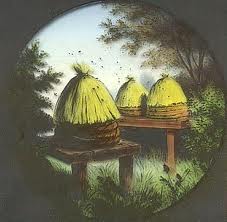I overwintered in triple deep hives. Twice.
It happened by accident. I ran out of shallow supers and used a deep instead. When fall rolled around, I was busy and didn’t harvest my honey. (I couldn’t have lifted that top deep anyway…) The next year I did the same thing.
My bees have done so well the past two winters, I thought about writing a post about it.
But when I consulted my Bee books, I realized I’d done something horribly wrong. I decided to keep it to myself.
Then yesterday, I received an email that rocked my world. I wasn’t the only one! Other beekeepers out there had discovered that their bees overwintered well in triple deep hives. Maybe even better!
Rusty of The Bee Suite said:
This post is a follow-up to “Rethinking the triple deep hive” that I ran earlier in the week. One reader asked me to expand on the comment, “The triple-deep nests were more-or-less in a column rather than a sphere. Hive inspections showed the brood nests spanning all three boxes in the very center.”
I made that observation last October when I was getting ready for winter. In the double-deep hives, the bees were generally in a sphere in the bottom box. I say “sphere” because the clusters were seven to eight frames wide and as deep as the deep frames–okay, a slightly flattened sphere, although in some cases the nest extended into the upper box for a few inches.
In the triple deeps, however, I found the clusters in the center of the middle box and extending both into the lower boxes and the upper boxes. The clusters in these hives were in what appeared to be a column about five frames wide in the center box, and three to four frames wide in the upper and lower boxes. These were definitely long and narrow nests, as opposed to spherical nests.
The configuration in the triple deeps irritated me at the time. Since I normally overwinter in double deeps, I had planned to take one brood box off each of the triple hives. But when I got in there, I saw no easy way to winnow it down to two with destroying at least part of each nest. So I just left them that way and, of course, they were the ones that survived the winter.
Scott Famous, a beekeeper from Pennsylvania, wrote in with several interesting observations. Scott overwinters in two deeps and a medium. He says,
. . . I have had clusters survive in that amount of space that were no bigger than a softball. . . . I think it’s just an insulation factor . . . because they’re always smack dab in the middle. I believe that staying in the middle of those boxes keeps them in “dead air” space better than anything smaller, and thereby allows them the least amount of draft and loss of cluster heat. . . . While the bees do benefit from a certain amount of air exchange, keeping it fresh, WITHOUT any drafts is just as important. Bees need “still air” in their boxes, in winter, with very little exchange, and NO DRAFTS.
I firmly believe it’s all about a balancing act of adequate air exchange, with NO fast moving air. . . . The combs/frames provide the perfect baffles against that type of air flow, while still letting the chimney effect of the cluster heat very slowly “pull” from the fresh air at the bottom, and ever-so-gently refresh the available air supply without active loss of cluster heat. . . .
It is very true that full combs of honey and pollen are very dense and have a high heat capacity. A high heat capacity means that their temperature will not fluctuate rapidly along with the outside temperature. So while the outside temps may rise and fall willy-nilly, the temperature of the full combs will remain much more constant.
If, as Scott points out, you can overwinter a softball-size cluster in a large hive, it stands to reason that all the extra honey is acting not only as a food source, but as insulating material.
The part I haven’t reconciled in my own mind is that a higher chimney has a greater draft. So, in theory at least, a taller hive will have more draft then a shorter one. And more air flow through the hive would remove more heat from the cluster. Yet, people consistently say that tall hives overwinter better. There are clearly factors here that I haven’t considered. If you have a theory, please chime in.
Rusty
HoneyBeeSuite
It’s good to know that I’m not alone in this. And I’m not planning on changing anytime soon.

